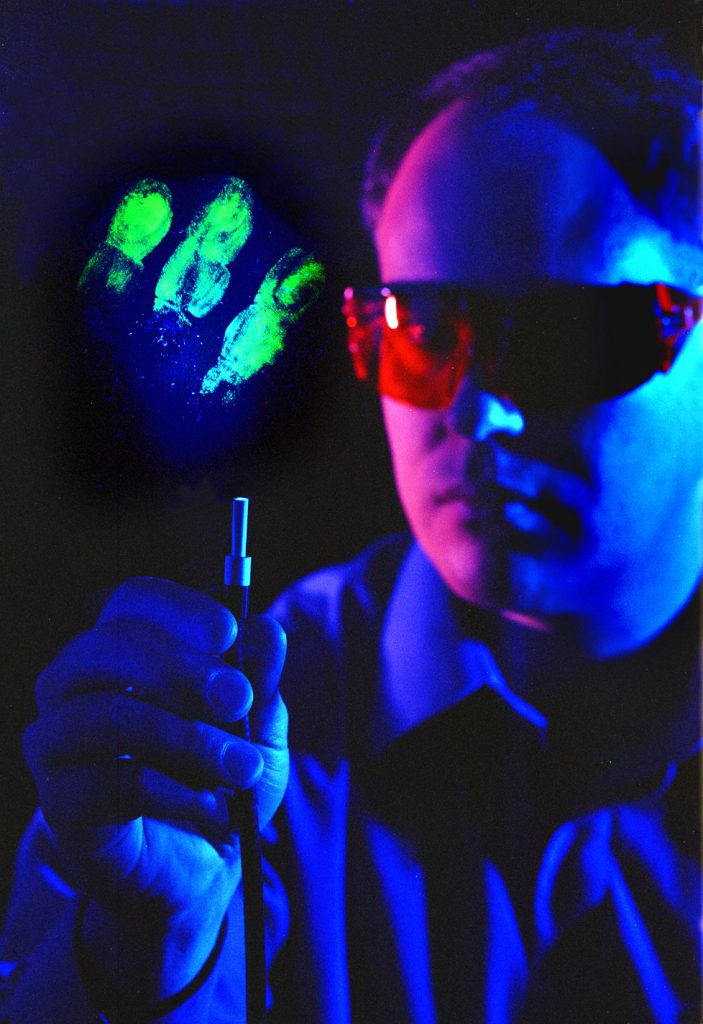
ALBUQUERQUE, N.M. — Some evidence is hard to find, particularly the kinds of evidence that can help police place the perpetrator at the scene of the crime — fingerprints, semen, urine, and other organic substances that carry clues to a criminal’s identity.
Now researchers at Sandia National Laboratories are developing an evidence-detection system that would — with the aid of a flashing lamp and a pair of modified 3-D video game goggles — make organic substances appear to blink, allowing investigators to locate potential evidence more quickly and in a lighted room if necessary. The National Institute of Justice, the research arm of the Department of Justice, has provided $393,000 for the project.
The researchers hope to begin testing a prototype of the system in 12 months and have it available for licensing and manufacture in 18 months. The Albuquerque Police Department’s crime lab has agreed to test a prototype system at actual crime scenes.
“If it works, this system would give us the ability to see things we haven’t been able to see more quickly and in ambient light,” says APD Criminalistics Director Ann Talbot.
An important feature of the system is its affordability, says Dave Sandison, lead researcher for the project. “We don’t want to develop something the FBI would have two of and nobody else could afford,” he says. “It would be accessible to police departments everywhere.”
The approach originates from a Department of Energy-sponsored weapons security project.
Less thinking when it’s blinking
To locate certain organic evidence, fingerprints for example, police typically rely on optical aids such as powders, lamps giving off various wavelengths of light, and yellow-tinted goggles that increase the evidence’s visibility. Even with these aids, investigators typically must conduct their investigations at night or in a darkened room. It can take hours to scour every inch of a crime scene.
Most fingerprints that are discovered are lifted from smooth surfaces such as glass windows or polished furniture, says Talbot. Latent fingerprints on walls and other textured surfaces are more difficult to find, and some kinds of organic evidence, such as semen or urine, don’t show themselves even with optical aids.
Sometimes fluorescent dyes are used in situations where they won’t contaminate other evidence, but rarely and as a last resort. “If you use chemicals, you typically have to spray down the entire room,” Talbot says. “That can get expensive.”
A lot of potential evidence can go unnoticed, she says.
Sandia’s proposed evidence-detection technique relies on the fact that all types of organic substances give off weak fluorescent emissions, normally invisible to the naked eye because other, much brighter sources of light interfere. The proposed system takes advantage of the periodic dissonance between two signals at slightly different frequencies — an effect called heterodyning — as well as the human eye’s natural affinity to anything that moves or blinks.
“We like to say, ‘There’s less thinking when it’s blinking,’ ” says Sandison.
On, off, on, off, on, off
In a nutshell, the system’s lamp is modulated at a specific frequency, say 100 times per second, which is to say it flashes at a rate too fast for the human eye to detect. The glasses, modified from a 3-D video game, shutter open and closed at a slightly different frequency, say 102 times per second, which essentially turns the user’s eyes on and off at a rate also too fast to be detected by the human eye. To the wearer, the lenses appear transparent.
Every so often, about twice a second, the glasses shutter open at the exact moment the lamp is “on,” which for a split second drowns out most background light whose wavelengths are different than that of the lamp. With the background light masked, the net effect is that the fluorescing materials appear to flash brightly at a rate that is distinctly noticeable to the human eye.
From behind the shuttered glasses, the crime-scene investigator would see the room lighted normally, but any organic substances would flash a few times per second when illuminated by the system’s lamp.
It’s like the combined sound two jetliner engines make, every once in a while humming in harmony and alternatingly reverberating in discord. The engines hum when the acoustic wavelengths match up. They clash when they don’t.
The researchers may also test the system using a low-light video camcorder that is more sensitive to the fluorescence than the human eye.
Law enforcement practicality
The APD crime lab tests are intended to help work out any bugs in the technique, define what kinds of evidence it can help find, and determine whether the system will be practical as a law enforcement tool.
“Who knows, we may turn the system on and see thousands of fingerprints,” Talbot says. “If we see too much, we won’t be able to sort out the real evidence.
“But if it works with some discretion and it’s portable, it would be useful to us on a fairly frequent basis. The beauty of this approach is that it doesn’t contaminate other evidence.”
It may be particularly useful at sexual assault crime scenes for identifying semen, which fluoresces much more brightly than the oils from fingertips. The researchers also hope to determine whether fresh fingerprints fluoresce more brightly than organic substances that have been there for awhile. If so, the system might be good at screening out evidence that isn’t pertinent to an investigation.
A related system is being used by a private company for detecting cancerous lesions in tissue samples. And Molecular Technologies Inc. (run by Ned Godshall, a Sandia researcher on entrepreneurial leave-of-absence) has applied fluorescence to the problem of DNA sequencing. The heterodyning technique originates from an early 1990s Sandia weapons security project.
Sandia is a multiprogram Department of Energy laboratory operated by Lockheed Martin Corp. With main facilities in Albuquerque and Livermore, Calif., Sandia has research and development programs contributing to national security, energy and environmental technologies, and economic competitiveness.
Technical contact:
Colin Smithpeter, csmithp@sandia.gov, (505) 844-9371